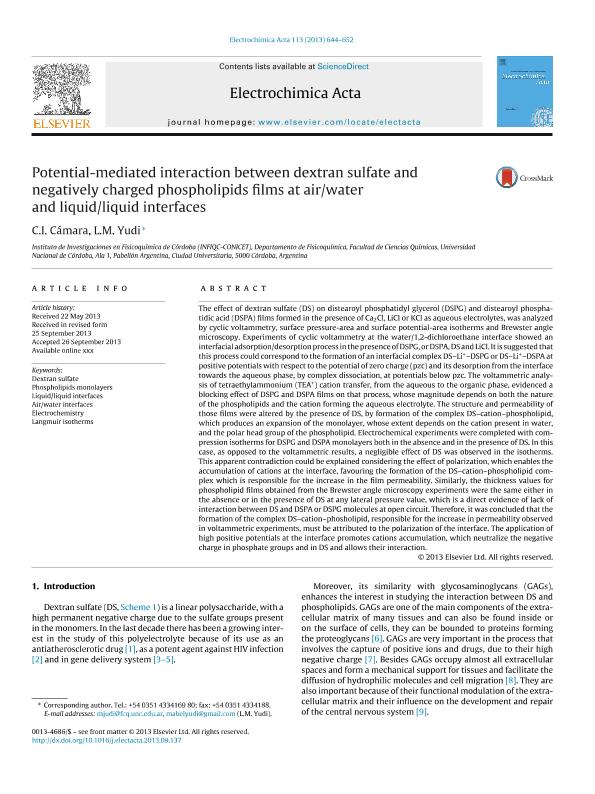Artículo
Potential-mediated interaction between dextran sulfate and negatively charged phospholipids films at air/water and liquid/liquid interfaces
Fecha de publicación:
10/2013
Editorial:
Elsevier
Revista:
Electrochimica Acta
ISSN:
0013-4686
Idioma:
Inglés
Tipo de recurso:
Artículo publicado
Clasificación temática:
Resumen
The effect of dextran sulfate (DS) on distearoyl phosphatidyl glycerol (DSPG) and distearoyl phosphatidic acid (DSPA) films formed in the presence of Ca2Cl, LiCl or KCl as aqueous electrolytes, was analyzed by cyclic voltammetry, surface pressure-area and surface potential-area isotherms and Brewster angle microscopy. Experiments of cyclic voltammetry at the water/1,2-dichloroethane interface showed an interfacial adsorption/desorption process in the presence of DSPG, or DSPA, DS and LiCl. It is suggested that this process could correspond to the formation of an interfacial complex DS–Li+–DSPG or DS–Li+–DSPA at positive potentials with respect to the potential of zero charge (pzc) and its desorption from the interface towards the aqueous phase, by complex dissociation, at potentials below pzc. The voltammetric analysis of tetraethylammonium (TEA+) cation transfer, from the aqueous to the organic phase, evidenced a blocking effect of DSPG and DSPA films on that process, whose magnitude depends on both the nature of the phospholipids and the cation forming the aqueous electrolyte. The structure and permeability of those films were altered by the presence of DS, by formation of the complex DS–cation–phospholipid, which produces an expansion of the monolayer, whose extent depends on the cation present in water, and the polar head group of the phospholipid. Electrochemical experiments were completed with compression isotherms for DSPG and DSPA monolayers both in the absence and in the presence of DS. In this case, as opposed to the voltammetric results, a negligible effect of DS was observed in the isotherms. This apparent contradiction could be explained considering the effect of polarization, which enables the accumulation of cations at the interface, favouring the formation of the DS–cation–phospholipid complex which is responsible for the increase in the film permeability. Similarly, the thickness values for phospholipid films obtained from the Brewster angle microscopy experiments were the same either in the absence or in the presence of DS at any lateral pressure value, which is a direct evidence of lack of interaction between DS and DSPA or DSPG molecules at open circuit. Therefore, it was concluded that the formation of the complex DS–cation–phosholipid, responsible for the increase in permeability observed in voltammetric experiments, must be attributed to the polarization of the interface. The application of high positive potentials at the interface promotes cations accumulation, which neutralize the negative charge in phosphate groups and in DS and allows their interaction.
Archivos asociados
Licencia
Identificadores
Colecciones
Articulos(INFIQC)
Articulos de INST.DE INVESTIGACIONES EN FISICO- QUIMICA DE CORDOBA
Articulos de INST.DE INVESTIGACIONES EN FISICO- QUIMICA DE CORDOBA
Citación
Cámara, Candelaria Inés; Yudi, Lidia Mabel; Potential-mediated interaction between dextran sulfate and negatively charged phospholipids films at air/water and liquid/liquid interfaces
; Elsevier; Electrochimica Acta; 113; 10-2013; 644-652
Compartir
Altmétricas




